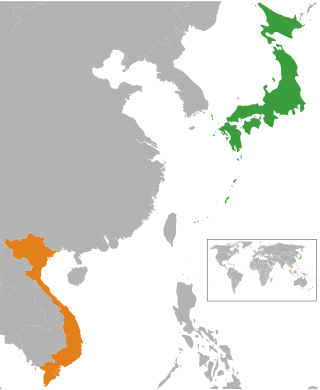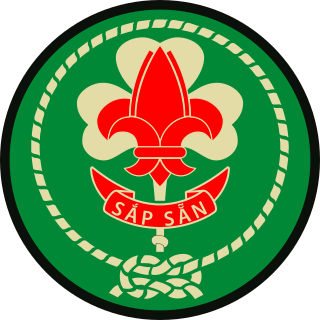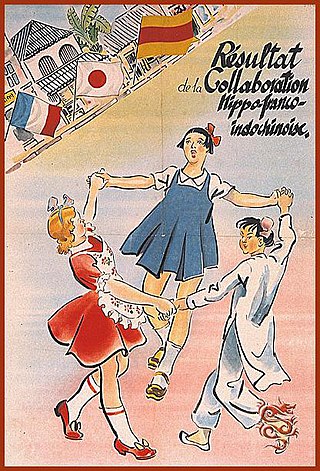
French Indochina, officially known as the Indochinese Union and after 1947 as the Indochinese Federation, was a grouping of French colonial territories in Southeast Asia until its demise in 1954. It comprised Cambodia, Laos, the Chinese territory of Guangzhouwan, and the Vietnamese regions of Tonkin in the north, Annam in the centre, and Cochinchina in the south. The capital for most of its history (1902–1945) was Hanoi; Saigon was the capital from 1887 to 1902 and again from 1945 to 1954.

Hồ Chí Minh, commonly known as Uncle Ho, President Hồ and by other aliases and sobriquets, was a Vietnamese communist revolutionary, nationalist, and politician. He served as Prime Minister of the Democratic Republic of Vietnam from 1945 to 1955, and as President from 1945 until his death in 1969. Ideologically a Marxist–Leninist, he was the Chairman and First Secretary of the Workers' Party of Vietnam, the predecessor of the current Communist Party of Vietnam.

The First Indochina War was fought between France and Việt Minh, and their respective allies, from 19 December 1946 until 20 July 1954. Việt Minh was led by Võ Nguyên Giáp and Hồ Chí Minh. Most of the fighting took place in Tonkin in Northern Vietnam, although the conflict engulfed the entire country and also extended into the neighboring French Indochina protectorates of Laos and Cambodia.

Phan Văn Khải was a Vietnamese politician who served as the fifth Prime Minister of Vietnam from 25 September 1997 until his resignation on 27 June 2006.

The August Revolution, also known as the August General Uprising, was a revolution launched by the Việt Minh against the Empire of Vietnam and the Empire of Japan in the latter half of August 1945. The Việt Minh, led by the Indochinese Communist Party, was created in 1941 and designed to appeal to a wider population than what the communists could command.

Huỳnh Tấn Phát was a Vietnamese architect, politician and revolutionary. He was the Prime Minister and de facto leader of the Provisional Revolutionary Government of South Vietnam during the Vietnam War. After unification, Phát became Deputy Prime Minister and Minister of Construction before serving as Vice President of Vietnam until his death. He is the designer of the flag of the Viet Cong.

Japanese–Vietnamese relations are over a millennium old, and the establishment of friendly trade relations can be traced to at least the 16th century. Modern relations between the two countries are based on Vietnam's developing economy and Japan's role as an investor and foreign aid donor. Although concerns about Japanese colonial past may rear up, as well as differences in contrasting political systems and as well as in human and economic development, the relation has still been kept cordial since. The Vietnamese has mostly accepted Japanese apologies for their actions in the war and Japan has played a major role in economic aid and trade to Vietnam since, as well as to other Southeast Asian nations.

The Vietnamese Scout Association is a youth organization that was established in Vietnam and active between 1930 and 1975. The association was recognized by the World Organization of the Scout Movement from 1957 to 1975.

French Cochinchina was a colony of French Indochina, encompassing the whole region of Lower Cochinchina or Southern Vietnam from 1862 to 1946. The French operated a plantation economy whose primary strategic product was rubber.

The Empire of Vietnam was a short-lived puppet state of Imperial Japan governing the former French protectorates of Annam and Tonkin between March 11 and August 25, 1945. At the end of its rule, the empire also successfully reclaimed Cochinchina as part of Vietnam.
Japanese language education in Vietnam first became widespread during the Empire of Vietnam, which was set up as a puppet state after Japan's 1941 World War II invasion of French Indochina. However, after Japan's 1945 surrender and withdrawal from Vietnam, there was little further education in the language until the 1970s. A 2006 survey showed 1,037 teachers teaching 29,982 students at 110 different institutions, an increase of 66% in the number of students since the previous year's survey. As of 2021, according to the Japan Foundation, 169,582 people were learning Japanese in Vietnam.

Prostitution in Vietnam is illegal and considered a serious crime. Nonetheless, Vietnam's Ministry of Labour, Invalids and Social Affairs (MOLISA) has estimated that there were 71,936 prostitutes in the country in 2013. Other estimates puts the number at up to 200,000.

The 1945–46 War in Vietnam, codenamed Operation Masterdom by the British, and also known as the Southern Resistance War by the Vietnamese, was a post–World War II armed conflict involving a largely British-Indian and French task force and Japanese troops from the Southern Expeditionary Army Group, versus the Vietnamese communist movement, the Viet Minh, for control of the southern half of the country, after the unconditional Japanese surrender.

The railway system in Vietnam is owned and operated by the state-owned Vietnam Railways. The principal route, the single track North-South Railway running between Hanoi and Ho Chi Minh City, accounts for 1,726 kilometres (1,072 mi) of the network's total length of 2,600 kilometres (1,600 mi). The national railway network uses mainly metre gauge, although there are several standard gauge and mixed gauge lines in the north of the country.

In mid-1940, Nazi Germany rapidly defeated the French Third Republic, and the colonial administration of French Indochina passed to the French State. Many concessions were granted to the Nazi-allied Empire of Japan, such as the use of ports, airfields, and railroads. Japanese troops first entered parts of Indochina in September 1940, and by July 1941 Japan had extended its control over the whole of French Indochina. The United States, concerned by Japanese expansion, started putting embargoes on exports of steel and oil to Japan from July 1940. The desire to escape these embargoes and to become self-sufficient in resources ultimately contributed to Japan's decision to attack on December 7, 1941, the British Empire and simultaneously the USA. This led to the USA declaring war against Japan on December 8, 1941. The US then joined the side of the British Empire, at war with Germany since 1939, and its existing allies in the fight against the Axis powers.

Karayuki-san (唐行きさん) was the name given to Japanese girls and women in the late 19th and early 20th centuries who were trafficked from poverty-stricken agricultural prefectures in Japan to destinations in East Asia, Southeast Asia, Siberia, Manchuria, British India, and Australia, to serve as sex workers.

1940—1946 in French Indochina focuses on events that happened in French Indochina during and after World War II and which influenced the eventual decision for military intervention by the United States in the Vietnam War. French Indochina in the 1940s was divided into four protectorates and one colony (Cochinchina). The latter three territorial divisions made up Vietnam. In 1940, the French controlled 23 million Vietnamese with 12,000 French soldiers, about 40,000 Vietnamese soldiers, and the Sûreté, a powerful police force. At that time, the U.S. had little interest in Vietnam or French Indochina as a whole. Fewer than 100 Americans, mostly missionaries, lived in Vietnam and U.S. government representation consisted of one consul resident in Saigon.

Japanese School in Ho Chi Minh City (JSHCM) is a Japanese international school in Tan Phu Ward, Phú Mỹ Hung, District 7, Ho Chi Minh City, Vietnam. It was established in 1997.
















